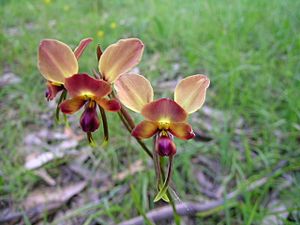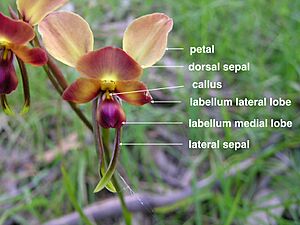Eastern donkey orchid facts for kids
Quick facts for kids Eastern wallflower orchid |
|
|---|---|
 |
|
| D. orientis growing in the Adelaide Hills | |
| Scientific classification | |
| Genus: |
Diuris
|
| Species: |
orientis
|
The Eastern wallflower orchid (scientific name: Diuris orientis) is a special type of orchid that only grows in eastern Australia. It's also known as the wallflower orchid. Like other orchids in its group, called Diuris, it has two petals that look a bit like ears. It's quite similar to the common donkey orchid (Diuris corymbosa) found in Western Australia. You can find this orchid in New South Wales, Victoria, South Australia and Tasmania. One way to tell it apart from its close relative, D. corymbosa, is that its stalk-like petal "claw" is shorter.
Contents
What Does the Eastern Wallflower Orchid Look Like?
The Eastern wallflower orchid grows from a tuber (a swollen underground stem, like a potato). It's a perennial plant, meaning it lives for more than two years. This plant is a terrestrial herb, which means it grows in the ground and has soft stems. It usually grows to be about 12–35 cm (5–10 in) tall.
Leaves and Flowers
This orchid has up to three leaves that grow from the base of the plant. Each leaf is long and narrow, about 10–30 cm (4–10 in) long and 5–10 mm (0.2–0.4 in) wide. They have a channel, or groove, down the middle.
The plant can have up to 6 yellow flowers. These flowers often have reddish-brown, purplish, and mauve markings. They grow on a flower stalk called a raceme, which can be 8–40 mm (0.3–2 in) high.
Parts of the Flower
- The dorsal sepal (the top part of the flower) stands upright. It's broadly egg-shaped, about 9–15 mm (0.4–0.6 in) long and wide.
- The lateral sepals (the side parts) are greenish-brown and hang down below the flower. They are long and narrow, about 12–23 mm (0.5–0.9 in) long and 3–4 millimetres (0.1–0.2 in)* wide. They might be parallel or sometimes crossed.
- The petals stand upright and spread out, looking like ears above the flower. They are broadly egg-shaped, about 12–20 millimetres (0.5–0.8 in)* long and 8–12 millimetres (0.3–0.5 in)* wide. They sit on a greenish-brown, stalk-like part called a "claw," which is 3–6 millimetres (0.1–0.2 in)* long. The similar Western Australian Diuris corymbosa has a longer claw.
- The labellum (the lip of the flower) is about 10–14 millimetres (0.4–0.6 in)* long and is divided into three parts.
- The side parts of the labellum are narrow and wedge-shaped, about 7–11 millimetres (0.3–0.4 in)* long.
- The middle part is 5–8 millimetres (0.2–0.3 in)* long, strongly folded, and has a rounded tip.
- There's also a callus (a raised area) near the base of the middle part of the labellum. It's a narrow, yellow ridge.
This orchid usually flowers between September and November.
How Was This Orchid Named?
The Eastern wallflower orchid, Diuris orientis, was first officially described in 1998. It was named by a botanist named David Jones. He found a specimen (a sample plant) in Beauty Point, Tasmania. The description was published in a scientific journal called Australian Orchid Research.
Meaning of the Name
The second part of its scientific name, orientis, is a Latin word. It means "east." This name was chosen because this orchid is found in the eastern parts of Australia. This helps to tell it apart from other similar orchids in the Diuris corymbosa group that grow further west.
Where Does the Eastern Wallflower Orchid Live?
The Eastern wallflower orchid is found in many places across South Australia, Tasmania, and Victoria. In New South Wales, it only grows in the very far southeast, especially in and near the Nadgee Nature Reserve.
In Victoria, you can often find it in open forests and areas with heath (a type of shrubland). It's interesting to note that after summer bushfires, there's a big increase in how many of these orchids flower!


